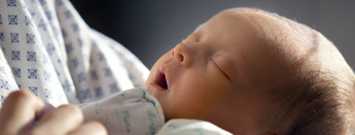Pulse Oximetry Screening for Critical Congenital Heart Defects
 In the US, about 7,200 (or 18 per 10,000) babies born each year have one of seven critical congenital heart defects (CCHDs)1. Learn more about how pulse oximetry screening potentially can identify these babies soon after birth.
In the US, about 7,200 (or 18 per 10,000) babies born each year have one of seven critical congenital heart defects (CCHDs)1. Learn more about how pulse oximetry screening potentially can identify these babies soon after birth.
What are critical congenital heart defects?
The seven defects classified as critical congenital heart defects (CCHDs) are hypoplastic left heart syndrome, pulmonary atresia (with intact septum), tetralogy of Fallot, total anomalous pulmonary venous return, transposition of the great arteries, tricuspid atresia, and truncus arteriosus. Babies with one these CCHDs are at significant risk for death or disability if their heart defect is not diagnosed and treated soon after birth. These seven CCHDs among some babies potentially can be detected using pulse oximetry screening, which is a test to determine the amount of oxygen in the blood and pulse rate. Certain hospitals routinely screen all newborns using pulse oximetry screening. However, pulse oximetry screening is not currently included in newborn screening in most states.
Other heart defects can be just as severe as these seven CCHDs and also require treatment soon after birth. However, pulse oximetry screening may not detect these heart defects as consistently as the seven disorders listed as CCHDs.
Did You Know?
- Congenital heart defects (CHDs) account for 30% of infant deaths due to birth defects1.
- Critical congenital heart defects (CCHDs) make up about 17-31% of all CHDs2.
- CCHDs require some type of intervention―often involving surgery―soon after birth.
Why is screening for critical congenital heart defects important?
Some babies born with a heart defect can appear healthy at first and can be sent home with their families before their heart defect is detected. It has been estimated that at least 300 infants with an unrecognized CCHD are discharged each year from newborn nurseries in the United States3. These babies are at risk for having serious problems within the first few days or weeks of life and often require emergency care.
Pulse oximetry newborn screening can identify some infants with a CCHD before they show any signs. Once identified, babies with a CCHD can be seen by cardiologists (heart doctors) and can receive specialized care and treatment that could prevent death or disability early in life. Treatment can include medications and surgery.
How are babies screened?
Pulse oximetry is a simple bedside test to determine the amount of oxygen in a baby's blood and the baby's pulse rate. Low levels of oxygen in the blood can be a sign of a CCHD. The test is done using a machine called a pulse oximeter, with sensors placed on the baby's skin. The test is painless and takes only a few minutes. Pulse oximetry screening does not replace a complete history and physical examination, which sometimes can detect a CCHD before oxygen levels in the blood become low. Pulse oximetry screening, therefore, should be used along with the physical examination.
 When are babies screened?
When are babies screened?
Screening is done when a baby is 24 to 48 hours of age. If the baby is to be discharged from the hospital before he or she is 24 hours of age, screening should be done as late as possible before discharge. Pulse oximetry screening is not currently included in newborn screening in most states.
What are pulse oximetry screening results?
If the results are "negative" (in-range result), it means that the baby's test results did not show signs of a CCHD. This type of screening test does not detect all CCHDs, so it is possible to still have a critical or other heart defect with a negative screening result. If the results are "positive" ("fail" or out-of-range result), it means that the baby's test results showed low levels of oxygen in the blood. This can be a sign of a CCHD. This does not always mean that the baby has a CCHD. It just means that more testing is needed.
The baby's doctor might recommend that the infant get screened again or have more specific tests, like an echocardiogram (an ultrasound picture of the heart), to diagnose a CCHD. Babies who are found to have a CCHD also might be evaluated by a clinical geneticist. This could help identify genetic syndromes associated with these heart defects and inform families about future risks.
What is CDC doing?
- CDC is assessing states’ needs for help with CCHD screening and reporting of screening results. CDC worked with New Jersey and Georgia to assess their ability to track CCHD screening. CDC is also helping states and hospitals to better understand how much hospitals spend for each baby screened.
- CDC promotes collaboration between birth defects tracking programs and newborn screening programs for CCHD screening activities. State birth defects programs collect data on CHDs and could help evaluate the effectiveness of screening by looking at false positives (babies who failed the CCHD screening but do not actually have a CCHD after further evaluation) and false negatives (babies who passed the screen suggesting there was no CCHD but actually did have a CCHD).
- CDC provides technical assistance to the Congenital Heart Public Health Consortium and to states receiving funding from the Health Resources and Services Administration (HRSA) for CCHD screening activities.
References:
- Broussard CS, Gilboa SM, Lee KA, Oster M, Petrini JR, Honein MA. Racial/Ethnic Differences in Infant Mortality Attributable to Birth Defects by Gestational Age. Pediatrics. 2012; 130:e518-27. [Read summary]
- Adapted from Knapp, AA, Metterville, DR, Kemper, AR, Prosser, L, Perrin, JM. Evidence review: Critical congenital cyanotic heart disease, Final Draft, September 3, 2010. Prepared for the Maternal and Child Health Bureau, Health Resources and Services Administration.
- Adapted from Aamir T, Kruse L, Ezeakudo O. Delayed diagnosis of critical congenital cardiovascular malformations (CCVM) and pulse oximetry screening of newborns. Acta Paediatr. 2007;96:1146-1149. [Read summary]
More Information
- CDC's National Center on Birth Defects and Developmental Disabilities
-
Podcasts
- Keeping Little Hearts Healthy (English)
- Folic Acid: Helping to Ensure a Healthy Pregnancy. (English or Spanish)
- Ten Tips to Prevent Infections during Pregnancy. (English or Spanish)
- Put Down That Drink if You Are Pregnant (or Trying to Be)! (English or Spanish)
- If You're Pregnant, Don't Smoke. (English or Spanish)
- Healthy Little Hearts (English)
CDC works 24/7 saving lives and protecting people from health threats to have a more secure nation. A US federal agency, CDC helps make the healthy choice the easy choice by putting science and prevention into action. CDC works to help people live longer, healthier and more productive lives.
- Page last reviewed: August 29, 2014
- Page last updated: January 23, 2012
- Content source:
- National Center on Birth Defects and Developmental Disabilities
- Page maintained by: Office of the Associate Director for Communication, Digital Media Branch, Division of Public Affairs




 ShareCompartir
ShareCompartir